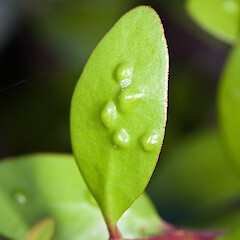Peraxilla tetrapetala
Common name
Red mistletoe, pikirangi, pirita, roeroe, pirinoa
Synonyms
Elytranthe tetrapetala (L.f.) Engl., Loranthus tetrapetalus L.f., Loranthus decussatus Kirk
Family
Loranthaceae
Flora category
Vascular – Native
Endemic taxon
Yes
Endemic genus
Yes
Endemic family
No
Structural class
Trees & Shrubs - Dicotyledons
NVS code
The National Vegetation Survey (NVS) Databank is a physical archive and electronic databank containing records of over 94,000 vegetation survey plots - including data from over 19,000 permanent plots. NVS maintains a standard set of species code abbreviations that correspond to standard scientific plant names from the Ngä Tipu o Aotearoa - New Zealand Plants database.
PERTET
Chromosome number
2 n= 24
Current conservation status
The conservation status of all known New Zealand vascular plant taxa at the rank of species and below were reassessed in 2017 using the New Zealand Threat Classification System (NZTCS) – more information about this can be found on the NZTCS website. This report includes a statistical summary and brief notes on changes since 2012 and replaces all previous NZTCS lists for vascular plants.
Please note, threat classifications are often suggested by authors when publications fall between NZTCS assessment periods – an interim threat classification status has not been assessed by the NZTCS panel.
- Conservation status of New Zealand indigenous vascular plants, 2017 . 2018. Peter J. de Lange, Jeremy R. Rolfe, John W. Barkla, Shannel P. Courtney, Paul D. Champion, Leon R. Perrie, Sarah M. Beadel, Kerry A. Ford, Ilse Breitwieser, Ines Schönberger, Rowan Hindmarsh-Walls, Peter B. Heenan and Kate Ladley. Department of Conservation. Source: NZTCS and licensed by DOC for reuse under the Creative Commons Attribution 4.0 International licence.
2017 | At Risk – Declining | Qualifiers: CD
Previous conservation statuses
2012 | At Risk – Declining | Qualifiers: CD
2009 | At Risk – Declining | Qualifiers: CD
2004 | Gradual Decline
Brief description
Fleshy shrub to 3m wide growing on inner branches of beech trees with glossy green fleshy paired leaves and masses of red tubular flowers. Leaves to 2.5cm long, blistered, diamond shaped. Flowers to 4cm long. Fallen petals litter forest floor under plants. Fruit green.
Distribution
North and South Island, but less common in the North Island.
Habitat
Coastal to montane. A hemiparasite whose main hosts are mountain beech (N. solandri var. cliffortioides), black beech (Nothofagus solandri var. solandri), red beech (N. fusca), and silver beech (N. menziesii). However, it has been recorded as a parasite on a further 17 species (2 exotic) including puriri (Vitex luceans) and pohutukawa (Metrosideros excelsa).
Detailed description
A shrub that can grow up to 2 m across. It usually parasitises close to the trunk of its host. It has characteristic small raised blisters or lesions on small, usually rhombic leaves. The flowers are solitary or 2-4 together and are bright red (up to 40 mm long). The ripe fruit is fleshy and green. Veins on the leaves are hardly evident and only the midrib is conspicuous. Leaf tips are never notched. Host trees are typically beech or Quintinia.
Similar taxa
Peraxilla colensoi, Ileostylus micranthus. Peraxilla tetrapetala has leaves mostly oblong or diamond-shaped, with blister galls, 1-3 flowers per flower cluster and dull green fruit. It grows on black and mountain beech. P. colensoi is generally larger, has 3-10 flowers per flower cluster, wider leaves, no blisters and bright yellow fruit and usually grows on silver beech. Ileostylus micranthus has green flowers and does not parasitise beech.
Flowering
October to January
Flower colours
Red/Pink
Fruiting
April to June
Propagation technique
Can be grown from fresh seed placed on suitable host tissue (ideally Nothofagus solandri var. cliffortioides). Although seed germinates readily the ability of the seedling to form a firm host is rather variable. Failure rates are high and experimentation with plenty of fresh seed is usually needed.
Threats
A wide variety of threats are now acknowledged as working in unison to cause the national decline of this and allied leafy mistletoes species. The most obvious threat seems to be brush tailed possums (Trichosurus vulpecula), which heavily browse mistletoes, to such an extent that they are held as the primary cause for the loss of the beech mistletoes from large parts of the countries beech forest.
Etymology
tetrapetala: Four winged
Where To Buy
Not commericially available.
Attribution
Fact sheet prepared by P.J. de Lange for NZPCN (1 June 2013)
References and further reading
NZPCN Fact Sheet citation
Please cite as: de Lange, P.J. (Year at time of access): Peraxilla tetrapetala Fact Sheet (content continuously updated). New Zealand Plant Conservation Network. https://www.nzpcn.org.nz/flora/species/peraxilla-tetrapetala/ (Date website was queried)
























